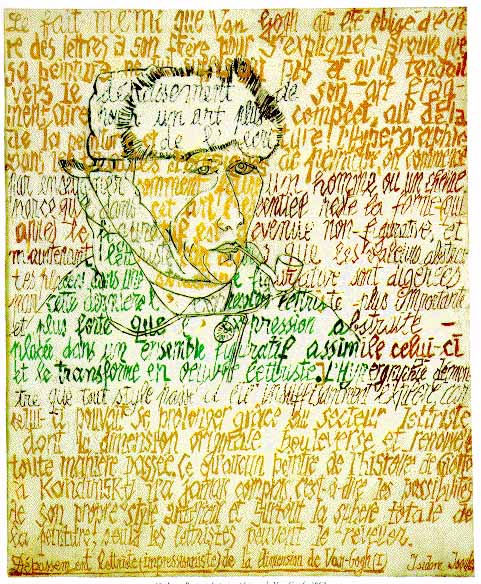What is Lettrism?
- jonathan-pradillon

- Dec 19, 2024
- 2 min read
Lettrism is an avant-garde artistic and cultural movement founded in 1945 by Isidore Isou, a poet and theorist of Romanian origin. This movement places the letter at the center of artistic creation, exploring its aesthetic potential beyond its traditional linguistic function. Lettrism seeks to reinvent the foundations of artistic and cultural expression by focusing on alphabetical and sound-based signs.

Origins and Historical Context of Lettrism
Lettrism emerged in the post-war period, a time of social and cultural upheaval. In 1945, Isidore Isou arrived in Paris with the ambition of revolutionizing the art world. In 1947, he published the "Manifesto of Lettrism," where he proposed transcending established artistic forms by placing letters and sounds at the heart of creation. For Isou, letters are not limited to their role in language but become autonomous visual and sound elements capable of expressing a new aesthetic.
Fundamental Principles of Lettrism
The Letter as Raw Material
Lettrism views the letter as an artistic material in its own right, detached from its function as a linguistic tool. By exploring letters as graphic and phonetic forms, lettrist artists create works that surpass the boundaries of verbal communication. This approach redefines the relationship between text, sound, and image.
Hypergraphy
Hypergraphy, developed within Lettrism, is a method that combines letters, symbols, numbers, and other sign systems to produce a universal visual language. It transcends the limits of traditional writing by offering a total form of writing where visual and textual elements coexist in a new form of expression.
Creatics or Novatics
Creatics, or novatics, is a philosophy developed by Isidore Isou. It is based on the idea that constant innovation is necessary in all artistic, cultural, and intellectual disciplines. Lettrism rejects stagnation and promotes the perpetual transformation of forms and ideas.
The Influence and Legacy of Lettrism
Although Lettrism never achieved widespread popularity, it significantly influenced several artistic movements, such as Situationism and certain branches of conceptual art. By redefining the foundations of art and exploring new forms of expression, Lettrism has inspired artists to push the boundaries of their practice.
Lettrism is a bold attempt to reinvent art and culture by focusing on letters and sounds as fundamental elements of expression. By exploring these basic units through a visual, auditory, and graphic lens, Lettrism opened new avenues for artistic creation. Its legacy remains an inspiration for those seeking to transcend conventions and innovate in their practices.
FAQ
When and by whom was Lettrism founded?
Lettrism was founded in 1945 by Isidore Isou.
What are the principles of Lettrism?
Lettrism emphasizes the use of letters as the primary material for artistic creation, develops hypergraphy, and promotes constant innovation through creatics.
What is hypergraphy?
Hypergraphy is a method that integrates various sign systems to create a total writing form, combining visual and textual elements.
What influence has Lettrism had?
It has influenced movements such as Situationism and conceptual art, encouraging the exploration of new forms of expression.
Why is creatics important in Lettrism?
Creatics promotes continuous transformation in artistic and intellectual disciplines, rejecting stagnation in favor of perpetual innovation.




Comments